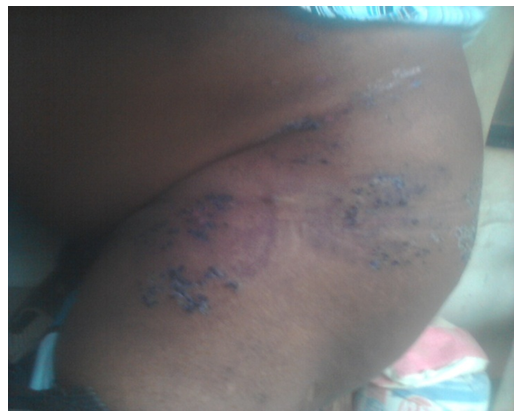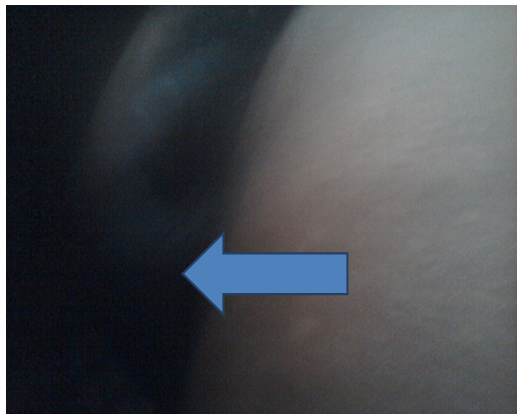-
Paper Information
- Previous Paper
- Paper Submission
-
Journal Information
- About This Journal
- Editorial Board
- Current Issue
- Archive
- Author Guidelines
- Contact Us
American Journal of Medicine and Medical Sciences
p-ISSN: 2165-901X e-ISSN: 2165-9036
2016; 6(3): 117-119
doi:10.5923/j.ajmms.20160603.08

An Unusual Case of Epididymo-Orchitis from Varicella Zoster Virus Infection; a Case Report in Awka, Nigeria
1Department of Internal Medicine, Imo State University Teaching Hospital, Orlu, Nigeria
2Department of Internal Medicine, Chukwuemeka Odumegwu Ojukwu University Teaching Hospital, Awka, Nigeria
Correspondence to: Ernest Ndukaife Anyabolu, Department of Internal Medicine, Imo State University Teaching Hospital, Orlu, Nigeria.
| Email: |  |
Copyright © 2016 Scientific & Academic Publishing. All Rights Reserved.
This work is licensed under the Creative Commons Attribution International License (CC BY).
http://creativecommons.org/licenses/by/4.0/

Background: Varicella zoster virus (VZV) infection does not commonly affect the urogenital system. Aim: Here, we report an unusual and rare case of VZV infection that presented as epididymo-orchitis and shingles in a patient in Awka, Nigeria. Findings: This was a 68 year-old man who developed shingles affecting the left lumbar 1 (L1) segment dermatomal area, simultaneously with left epididymo-orchitis, on a background of diabetes mellitus. Scrotal sonography showed evidence of varicosities and enlargement of left testis and epididymis. He was placed on acyclovir and gabapentin. After 3 weeks on follow-up, epididymo-orchitis resolved and shingles remitted. Conclusions: This case report of unusual and rare VZV infection that manifested as concomitant epididymo-orchitis and ipsilateral L1 dermatomal shingles, occurring in an adult in Awka, Nigeria, shows that the diagnosis of VZV epididymo-orchitis, in our setting, would be difficult without concurrent shingles, and will require a high index of suspicion.
Keywords: Epididymo-orchitis, Shingles, Varicella zoster virus infection, Awka, Nigeria
Cite this paper: Ernest Ndukaife Anyabolu, An Unusual Case of Epididymo-Orchitis from Varicella Zoster Virus Infection; a Case Report in Awka, Nigeria, American Journal of Medicine and Medical Sciences, Vol. 6 No. 3, 2016, pp. 117-119. doi: 10.5923/j.ajmms.20160603.08.
1. Introduction
- Varicella zoster virus (VZV) is one of the herpes viruses that affect humans. Infection by VZV has a bimodial pattern of manifestation. [1] In the primary phase, many organs of the body may be affected. They include the skin, lungs, and testes, among others. [2] Skin involvement manifests as chickenpox and testes as orchitis. [2]Following the primary phase of VZV infection, the virus hibernates in nerves as well as blood vessels for a long latency period of months to years. [3] During the secondary or reactivation phase, many organs, including the skin and testes, can be involved. In this phase, skin lesions manifest as shingles. [3, 4]Involvement of the testes by VZV is rare in adults in both the primary and secondary phases of the infection. [5] Similarly, concomitant occurrence of shingles and orchitis is rare. From literature search, there is a paucity of reports on VZV orchitis in adults emanating from Nigeria. We thus report an unusual case of epididymo-orchitis from VZV infection occurring concomitantly with shingles in a man in Awka, Nigeria, who has background diabetes mellitus and some episodes of depression.
2. Case Presentation
- Patient presented in the Medical Out-Patient Clinic of Chukwuemeka Odumegwu Ojukwu University Teaching Hospital, Awka, Nigeria, with the complaint of left groin rash and testicular pain, both of 1 week. He was apparently well until 1 week when he developed rashes in the left groin. Rashes were associated with pain and itching. About the same time, patient also noticed pain and swelling of testis. He has associated low grade fever, malaise and anorexia. There was no associated hematuria, hesitancy of urination, feeling of incomplete voiding, or dribbling of urine. He has significant exposure to cold; from the chilling impart of his air conditioned car, to the untiring ventilation of the fan in his office and house.He could not remember suffering from chicken pox in the past. He is a known diabetes mellitus patient diagnosed about 15 years ago. He has been compliant with his oral antidiabetic medications. He is not a known hypertensive patient. However, he has suffered some episodes of depression but has been stable.There was no family history of diabetes mellitus. He is the first of 5 siblings, married and has 5 children, all alive and well. A Medical Laboratory scientist, though retired from the Civil Service about 20 years ago, he still runs his private laboratory services.He has significant alcohol use –about 4-6 units of alcohol daily since about 30 years. He also has significant cigarette use, about 10 sticks per day, also spanning about 30 years. He lives with his family. In summary, patient, an elderly man, presented with left groin itchy, painful groin rashes of 1 week and concurrent painful swelling of testis. He is a known diabetes mellitus patient that has some episodes of depression.Physical examination showed an elderly man, conscious, but in obvious painful distress, acutely ill-looking, febrile, not pale, anicteric, has no peripheral lymph gland enlargement and no peripheral edema. His pulse rate was 78 beats per minute, of full volume and regular, and blood pressure 130/80 mmHg, sitting. Apex beat was at the 5th left intercostal space in the mid-clavicular line. Heart sounds, S1 and S2, were heard. There was no murmur and no crepitation. Crops of papulo-vesicular rashes and scratch marks were noted in the dermatomal area of the lumbar 1 (L1) segment. Abdomen was full, with no area of tenderness. Liver, spleen and kidneys were not enlarged. Central nervous system examination showed he was fully conscious, oriented in time, place and person. Memory, both recent and remote, was intact. There was no neck stiffness; Kernig’s and Brudzunski’s signs were absent. He has no other neurological deficit. Uro-genital system examination revealed that the left testis was tender and enlarged. Digital rectal examination showed neat anal verge, and good sphincteric tone. Prostate was non-tender, firm, and smooth, with preserved median sulcus. Well-formed feces was noticed on the examining fingers.Assessment of shingles and VZV epididymo-orchitis on a background of diabetes mellitus was made. He was commenced on Acyclovir 800mg tds x 14 days, Gabapentin 400mg bd x 14 days, and advised to avoid exposure to cold and ingestion of cold substances. Investigations showed normal full blood count (FBC), urinalysis and urine microscopy; urine culture did not yield any bacterial growth. Sonography revealed that the right testis measured 32.0mm x 22.0mm with a central hypoechoic area 22.0mm x 13.7mm. On the left, there was profuse varicosities; the largest diameter was 2.2mm. The left testis was shaggy and measured 45.4mm x 25.6mm. Prostate gland measured 48.3mm x 33.2mm x 5.8mm; texture was hypoechoic and wall emarginated. Fasting blood sugar (FBS), fasting serum lipid profile (FSLP), prostatic specific antigen (PSA) were within normal limits. Figures 1 and 2 are pictures of the patient showing shingles and scrotal swelling.
 | Figure 1. Picture of patient showing shingles and scrotal swelling |
 | Figure 2. Picture of patient showing scrotal swelling |
3. Discussion
- In both the primary and reactivation phases of VZV infection many organs, including the testes, can be involved. VZV can spread by nerve axis or bloodstream and cause direct organ involvement. [6] Arterial and venous vasculopathy has been documented as the cause of central nervous system and other organ involvement. [7] Our index patient has left epididymo-orchitis and shingles in the L1 dermatomal area, suggesting etiologic commonality, possibly nervous, vascular, or a combination of the two.Orchitis usually presents with testicular pain, and fever that may be low grade. Our index patient has left painful testicular swelling. Urinalysis and full blood count may be normal in viral orchitis, [8] including VZV infection, as was observed in our patient. We did not perform PCR for VZV or VZV IgG antibody to confirm VZV infection. However, the concurrent finding of epididymo-orchitis and shingles in the same nerve segment distribution clinically suggested a diagnosis of VZV infection as the single cause of the lesions simultaneously occurring in the two different anatomic areas. Nevertheless, vasculopathy in VZV infection is non-specific, may not occur dermatomally, as the lesions may be diffuse. [9]Varicosities were noted on sonography of our patient. Vasculopathy has been reported as the mechanism for CNS lesions seen in VZV. [6, 9] Although no report was found on literature search on vasculopathic involvement of the testes or epididymis by VZV, varicosities can result from a vasculopathy. [10] Perhaps, varicosities in this patient could be explained by the VZV infection. The reactivation phase of VZV infection flourishes in the setting of immunocompromise. [5] This was observed in our patient: he has diabetes mellitus and episodes of depression, both of which compromise immunity. [5]Epididymo-orchitis, usually does not occur concomitantly with shingles. [11] Expectedly, in our setting, a diagnosis of isolated VZV epididymo-orchitis would be difficult. In this case report, the clinical diagnosis of VZV epididymo-orchitis was possible because of the high index of suspicion occasioned by the concomitant occurrence of shingles in the same nerve segmental anatomic region.
4. Conclusions
- This case report of an unusual, rare VZV infection that manifested as concomitant epididymo-orchitis and ipsilateral L1 dermatomal shingles, occurring in a patient in Awka, Nigeria, shows that the diagnosis of VZV epididymo-orchitis, in our setting, would be elusive without a high index of suspicion occasioned by the concomitant occurrence of shingles.
 Abstract
Abstract Reference
Reference Full-Text PDF
Full-Text PDF Full-text HTML
Full-text HTML